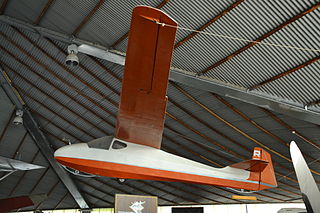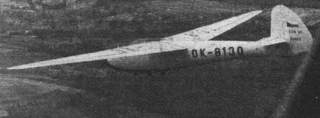
The ASK 13 is a two-seater glider that was built by German sailplane manufacturer Alexander Schleicher Gmbh & Co. It was and still is widely used for basic training of glider pilots.

The Schleicher K 8 is a single-seat glider designed by Rudolf Kaiser and built by the Alexander Schleicher company of Germany.

The Schleicher ASK 18 is a single-seat sailplane that was built by the German manufacturer Alexander Schleicher GmbH & Co. It was designed to be a sturdy aircraft for inexperienced solo pilots and so uses a simple and rugged construction and has docile handling characteristics.

The Slingsby Type 42 Eagle was a two-seat glider designed in England from 1952.

The Carden-Baynes Bee was a 1930s British two-seat aircraft, with twin engines in pusher configuration buried in the wings. The wings rotated for storage. Financial problems limited the Bee to a single flight.

The Carden–Baynes Auxiliary was the first motor glider with a retractable engine and propeller; it is known as the Abbott–Baynes Scud 3 when engineless. Both aircraft, built in the mid-1930s, were still flying in 2010 as pure sailplanes.
The ICA IS-23 was a single-engined high-wing monoplane with STOL capability that was built in Romania in the 1960s. It was developed into the similar ICA IS-24.

The Dyn'Aéro CR.100 is a French kit built single engine, two-seat monoplane, developed in the 1990s and intended as both an aerobatic trainer and a tourer, primarily for aero club use.
The I.S.T. L-17 Masang was a two-seat, single engine, low wing monoplane aircraft designed and built in the Philippine Republic in the mid-1950s. It was intended for both touring and training.
The Broburn Wanderlust was a small, wooden, single-seat glider designed in the United Kingdom just after World War II. Only one was built, though it was well used.
The Manuel Hawk was a homebuilt single-seat glider designed and constructed in the UK around 1970. Only one example was flown.
The Bréguet Br 900 Louisette was a short-span, single-seat competition sailplane built in France in the 1940s. It set some French gliding records but was unsuccessful at the international level. Only six production aircraft were built.

The SGP M-222 Flamingo was an Austrian twin engine, four seat light aircraft, developed with a series of prototypes into the early 1960s. There was no series production.
The Aviomilano CPV1, also known as the Arlecchino, was an Italian high performance sailplane built in the early 1960s. Only one was built.
The IIL IS-9 was a low powered, experimental pod and boom style motor glider, designed and built in Romania in the late 1950s.
The IIL IS-11 was an aerobatic, single seat glider, designed and built in Romania in 1959. It was built in small numbers.
The IIL IS-12 was a two-seat glider, designed and built in Romania in 1960. It had a wooden wing but a metal fuselage and was constructed in parallel with the all-wood IS-13 for comparative tests. It was later followed by the IS-13a, a version with an all-metal wing.

The Schneider ES-57 Kingfisher is a low-cost, short-span Australian glider capable of respectable cross country soaring flights. It was produced in small numbers in the late 1950s.

The Zlín Šohaj series of club gliders began as a post World War II development of the DFS Olympia Meise. A large number were built in the 1940s and '50s.

The RRG Storch V was the only member of Alexander Lippisch's Storch series of tailless aircraft to be powered. It flew successfully in the year 1929.











